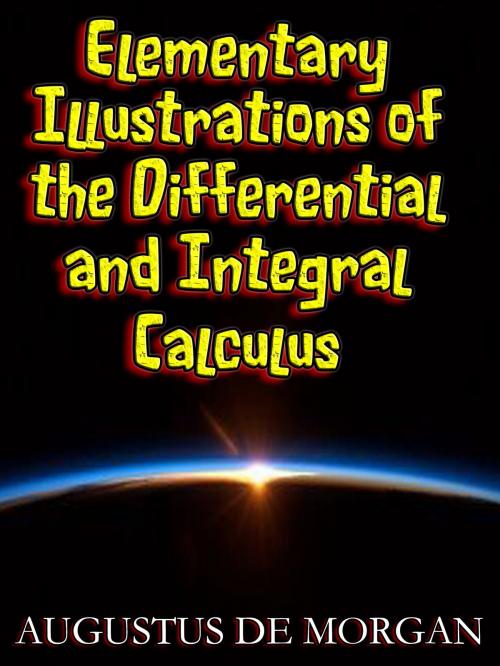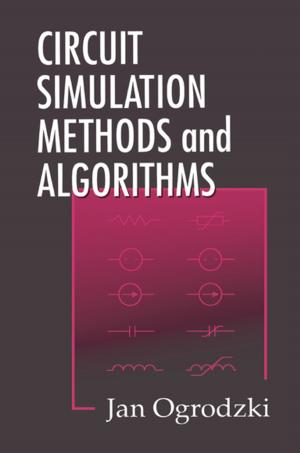Elementary Illustrations of the Differential and Integral Calculus (Illustrated)
Nonfiction, Science & Nature, Mathematics, Differential Equations, Calculus, Technology, Engineering| Author: | Augustus De Morgan | ISBN: | 1230000145222 |
| Publisher: | De Morgan | Publication: | June 26, 2013 |
| Imprint: | Language: | English |
| Author: | Augustus De Morgan |
| ISBN: | 1230000145222 |
| Publisher: | De Morgan |
| Publication: | June 26, 2013 |
| Imprint: | |
| Language: | English |
DIFFERENTIAL AND INTEGRAL CALCULUS.
ELEMENTARY ILLUSTRATIONS.
The Differential and Integral Calculus, or, as it was formerly called, the Doctrine of Fluxions, has always been supposed to present remarkable obstacles to the beginner. It is matter of common observation that anyone who commences this study, even with the best elementary works, finds himself in the dark as to the real meaning of the processes which he learns, until, at a certain stage of his progress, depending upon his capacity, some accidental combination of his own ideas throws light upon the subject.
The reason of this may be that it is usual to introduce him at the same time to new principles, processes, and symbols, thus preventing his attention from being exclusively directed to one new thing at a time. It is our belief that this should be avoided; and we propose, therefore, to try the experiment, whether by undertaking the solution of some problems by common algebraic methods, without calling for the reception of more than one new symbol at once, or lessening the immediate evidence of each investigation by reference to general rules, the study of more methodical treatises may not be somewhat facilitated.
We would not, nevertheless, that the student should imagine we can remove all obstacles; we must introduce notions, the consideration of which has not hitherto occupied his mind; and shall therefore consider our object as gained, if we can succeed in so placing the subject before him, that two independent difficulties shall never occupy his mind at once.
CONTENTS:
On the Ratio or Proportion of Two Magnitudes
On the Ratio of Magnitudes that Vanish Together
On the Ratios of Continuously Increasing or Decreasing Quantities
The Notion of Infinitely Small Quantities
On Functions
Infinite Series
Convergent and Divergent Series
Taylor's Theorem Derived Functions
Differential Coefficients
The Notation of the Differential Calculus
Algebraic Geometry
On the Connexion of the Signs of Algebraic and the Directions of Geometrical Magnitudes
The Drawing of a Tangent to a Curve
Rational Explanation of the Language of Leibnitz
Orders of Infinity
A Geometrical Illustration: Limit of the Intersections of Two Coinciding Straight Lines
The Same Problem Solved by the Principles of Leibnitz
An Illustration from Dynamics: Velocity, Acceleration, etc.
Simple Harmonic Motion
The Method of Fluxions
Accelerated Motion Limiting Ratios of Magnitudes that Increase Without Limit
Recapitulation of Results Reached in the Theory of Functions
Approximations by the Differential Calculus
Solution of Equations by the Differential Calculus
Partial and Total Differentials
Application of the Theorem for Total Differentials to the Determination of Total Resultant Errors
Rules for Differentiation
Illustration of the Rules for Differentiation
Differential Coefficients of Differential Coefficients
Calculus of Finite Differences Successive Differentiation
Total and Partial Differential Coefficients Implicit Differentiation
Applications of the Theorem for Implicit Differentiation
Inverse Functions
Implicit Functions
Fluxions and the Idea of Time
The Differential Coefficient Considered with Respect to its Magnitude
The Integral Calculus
Connexion of the Integral with the Differential Calculus
Nature of Integration
Determination of Curvilinear Areas the Parabola
Method of Indivisibles
Concluding Remarks on the Study of the Calculus
Bibliography of Standard Text-books and Works of Reference on the Calculus
DIFFERENTIAL AND INTEGRAL CALCULUS.
ELEMENTARY ILLUSTRATIONS.
The Differential and Integral Calculus, or, as it was formerly called, the Doctrine of Fluxions, has always been supposed to present remarkable obstacles to the beginner. It is matter of common observation that anyone who commences this study, even with the best elementary works, finds himself in the dark as to the real meaning of the processes which he learns, until, at a certain stage of his progress, depending upon his capacity, some accidental combination of his own ideas throws light upon the subject.
The reason of this may be that it is usual to introduce him at the same time to new principles, processes, and symbols, thus preventing his attention from being exclusively directed to one new thing at a time. It is our belief that this should be avoided; and we propose, therefore, to try the experiment, whether by undertaking the solution of some problems by common algebraic methods, without calling for the reception of more than one new symbol at once, or lessening the immediate evidence of each investigation by reference to general rules, the study of more methodical treatises may not be somewhat facilitated.
We would not, nevertheless, that the student should imagine we can remove all obstacles; we must introduce notions, the consideration of which has not hitherto occupied his mind; and shall therefore consider our object as gained, if we can succeed in so placing the subject before him, that two independent difficulties shall never occupy his mind at once.
CONTENTS:
On the Ratio or Proportion of Two Magnitudes
On the Ratio of Magnitudes that Vanish Together
On the Ratios of Continuously Increasing or Decreasing Quantities
The Notion of Infinitely Small Quantities
On Functions
Infinite Series
Convergent and Divergent Series
Taylor's Theorem Derived Functions
Differential Coefficients
The Notation of the Differential Calculus
Algebraic Geometry
On the Connexion of the Signs of Algebraic and the Directions of Geometrical Magnitudes
The Drawing of a Tangent to a Curve
Rational Explanation of the Language of Leibnitz
Orders of Infinity
A Geometrical Illustration: Limit of the Intersections of Two Coinciding Straight Lines
The Same Problem Solved by the Principles of Leibnitz
An Illustration from Dynamics: Velocity, Acceleration, etc.
Simple Harmonic Motion
The Method of Fluxions
Accelerated Motion Limiting Ratios of Magnitudes that Increase Without Limit
Recapitulation of Results Reached in the Theory of Functions
Approximations by the Differential Calculus
Solution of Equations by the Differential Calculus
Partial and Total Differentials
Application of the Theorem for Total Differentials to the Determination of Total Resultant Errors
Rules for Differentiation
Illustration of the Rules for Differentiation
Differential Coefficients of Differential Coefficients
Calculus of Finite Differences Successive Differentiation
Total and Partial Differential Coefficients Implicit Differentiation
Applications of the Theorem for Implicit Differentiation
Inverse Functions
Implicit Functions
Fluxions and the Idea of Time
The Differential Coefficient Considered with Respect to its Magnitude
The Integral Calculus
Connexion of the Integral with the Differential Calculus
Nature of Integration
Determination of Curvilinear Areas the Parabola
Method of Indivisibles
Concluding Remarks on the Study of the Calculus
Bibliography of Standard Text-books and Works of Reference on the Calculus















